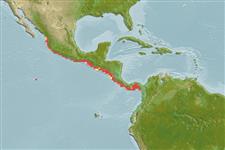>
Pleuronectiformes (Flatfishes) >
Cynoglossidae (Tonguefishes) > Symphurinae
Etymology: Symphurus: Greek, syn, symphysis = grown together + Greek, oura = tail (Ref. 45335); melasmatotheca: From the Greek word melasma, a black spot, and theke meaning a case or covering, referring to the black peritoneum; the epithet treated as a noun in apposition (Ref. 10739).
Environment: milieu / climate zone / depth range / distribution range
Ecologia
marinhas demersal; intervalo de profundidade 15 - 111 m (Ref. 9294), usually 15 - 60 m (Ref. 9294). Tropical; 24°N - 6°N
Eastern Pacific: Mexico to Panama. Recorded from Peru (Ref. 10739).
Tamanho / Peso / Idade
Maturity: Lm ? range ? - ? cm
Max length : 13.6 cm SL macho/indeterminado; (Ref. 9294); common length : 11.0 cm SL macho/indeterminado; (Ref. 9294)
Descrição suscinta
Chaves de identificação | Morfologia | Morfometria
Espinhos dorsais (total) : 0; Raios dorsais (total) : 90 - 98; Espinhos anais: 0; Raios anais : 74 - 80; Vértebras: 49 - 52.
Probably taken as bycatch of trawl fisheries (Ref. 9294).
Ciclo de vida ou comportamento de acasalamento
Maturities | Reprodução | Spawnings | Egg(s) | Fecundities | Larvas
Munroe, T.A., F. Krupp and M. Schneider, 1995. Cynoglossidae. Lenguas, lenguetas. p. 1039-1059. In W. Fischer, F. Krupp, W. Schneider, C. Sommer, K.E. Carpenter and V. Niem (eds.) Guia FAO para Identification de Especies para lo Fines de la Pesca. Pacifico Centro-Oriental. 3 Vols. FAO, Rome. (Ref. 9294)
Status na Lista Vermelha da UICN (Ref. 130435)
Ameaça para os humanos
Harmless
Uso pelos humanos
Ferramentas
Relatórios especiais
Baixar XML
Fontes da internet
Estimates based on models
Preferred temperature (Ref.
123201): 19.8 - 28.9, mean 27.5 °C (based on 66 cells).
Índice de diversidade filogenética (Ref.
82804): PD
50 = 0.5000 [Uniqueness, from 0.5 = low to 2.0 = high].
Bayesian length-weight: a=0.01445 (0.00647 - 0.03228), b=3.05 (2.85 - 3.25), in cm total length, based on LWR estimates for this (Sub)family-body shape (Ref.
93245).
Nível Trófico (Ref.
69278): 3.3 ±0.4 se; based on size and trophs of closest relatives
Resiliência (Ref.
120179): Elevada, tempo mínimo de duplicação da população menor que 15 meses (Preliminary K or Fecundity.).
Fishing Vulnerability (Ref.
59153): Low vulnerability (10 of 100).
